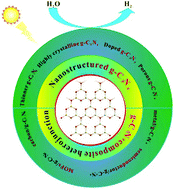Semiconductor polymeric graphitic carbon nitride photocatalysts: the “holy grail” for the photocatalytic hydrogen evolution reaction under visible light
Abstract
Semiconductor polymeric graphitic carbon nitride (g-C3N4) photocatalysts have attracted dramatically growing attention in the field of the visible-light-induced hydrogen evolution reaction (HER) because of their facile synthesis, easy functionalization, attractive electronic band structure, high physicochemical stability and photocatalytic activity. This review article presents a panorama of the latest advancements in the rational design and development of g-C3N4 and g-C3N4-based composite photocatalysts for HER application. Concretely, the review starts with the development history, synthetic strategy, electronic structure and physicochemical characteristics of g-C3N4 materials, followed by the rational design and engineering of various nanostructured g-C3N4 (e.g. thinner, highly crystalline, doped, and porous g-C3N4) photocatalysts for HER application. Then a series of highly efficient g-C3N4 (e.g., metal/g-C3N4, semiconductor/g-C3N4, metal organic framework/g-C3N4, carbon/g-C3N4, conducting polymer/g-C3N4, sensitizer/g-C3N4) composite photocatalysts are exemplified. Lastly, this review provides a comprehensive summary and outlook on the major challenges, opportunities, and inspiring perspectives for future research in this hot area on the basis of pioneering works. It is believed that the emerging g-C3N4-based photocatalysts will act as the “holy grail” for highly efficient photocatalytic HER under visible-light irradiation.



 Please wait while we load your content...
Please wait while we load your content...